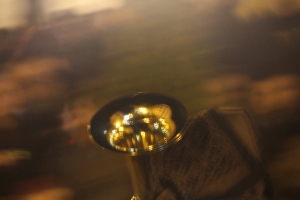Capas Pardas
After watching the Cofradía del Silencio, I met with Isabel and we planned to go to see the “Capas Pardas.” This is another procession that she likes a lot but doesn’t actually enjoy watching. While beautiful, this procession moves at an incredibly slow pace. It begins at midnight and ends at probably four in the morning. Where we were, it took until 1am for them to arrive, and we didn’t bother to stay and watch them pass. It was too cold and we were still tired from Via Crucis.
The full name of this procession is Hermandad de Penitencia del Santísimo Cristo del Amparo. This procession is very different from the others, which is what makes it special. The 150 cofrades wear a capucha (a regular hood) instead of the capirotes (the pointed hood). Their tunics and hoods are all of a brownish-grey color (parda), and the hoods are elaborately decorated in the style of Aliste, a nearby town. In other processions, a band will announce the arrival of the procession, but in the Capas Pardas, matracas (rattles) serve the same purpose. Each person goes very slowly, stopping after every few steps. They walk with their head down, carrying a lantern (farol) that illuminates only the middle of their body.
As the procession was passing us in the Plaza San Ildefonso, the “Vía Crucis” were read. These are the fourteen stages of the story of Jesus carrying the cross. You can read about them (in Spanish) here. This procession only has one paso, called Cristo del Amparo. It is from the 17th century and the creator is unknown. At the end of the procession, they sing “Miserere castellano” in the Plaza San Claudio.
Links
Cofradía Virgen de la Esperanza
The next morning (Thursday), I caught the middle part of this procession as it passed through the Plaza Mayor. Isa’s apartment faces the plaza, so it makes it very convenient to watch the processions when you have just woken up. The procession started at 10.30am; however, it wasn’t until 12.30, when the music was at its loudest, that I woke up and went downstairs and out onto the balcony to take a few photos. As an example of how small Zamora is, a friend of Isa’s dad saw me on the balcony and called to tell her father that his American guest was on the balcony in a t-shirt (the horrors!). I was also barefoot, but he couldn’t see that. Objectively it was a bit cold, but I couldn’t feel it at all. (I hate when people tell me to dress warmer when I’m not cold).
This procession is known for the imagen of the Virgin Mary crying for Jesus. The cofrades are all men. Following the paso are the only women, wearing all black with a peineta espanola (the comb holding up the veil). They are called damas de luto (women in mourning) and dress as they did for funerals in ages past. The lace veil that they wear is called mantilla and it means both lace and shawl in English. In reference to this procession, the booklet on Zamora’s Semana Santa also says the hood is called caperuz. This is the most common name in Zamora.
- La Virgen de la Esperanza, de Víctor de los Ríos, 1950
- The paso making its way through the Plaza Mayor
- Las Damas de Luto, wearing the peineta and the mantilla
- Cofrades
- Here you can catch a glimpse of the costaleros carrying the paso
- My favorite thing about the kid cofrades is that they don’t look like children. They seem to only be miniature cofrades.
- Exiting the Plaza Mayor








